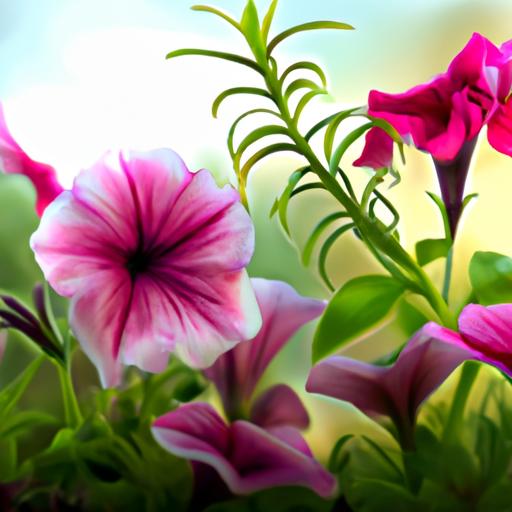Have you ever marveled at the sight of beautiful butterflies fluttering around your garden? Have you ever wished to have a garden full of these vibrant creatures? If so, then you should consider planting petunias! Petunias are not only a beautiful flower, but they can be an effective way to attract butterflies to your garden.
In this comprehensive guide, we will explore what petunias are, why they attract butterflies, and how to plant and care for them to create the perfect environment for these beautiful creatures.
Read on to learn more about how you can create a garden of delightful petunias and butterflies!
Table of Contents
Short Answer
Yes, petunias are known to attract butterflies.
Petunias are part of the Solanaceae family of flowering plants, which are known to be attractive to butterflies.
The bright, colorful petals of petunias, along with their sweet nectar, make them particularly attractive to butterflies.
Additionally, the shape of petunias make them easy for butterflies to land on and sip the nectar.
What Are Petunias?
Petunias are a type of flowering plant that can be found in a variety of shapes, sizes, and colors.
These annual plants are native to South America but have since spread across the world due to their popularity in gardens and outdoor spaces.
Petunias are known for their bright colors and sweet fragrance, making them a favorite among butterflies and other pollinators.
Petunias are easy to grow and require minimal maintenance.
They can be planted in a variety of ways, including in containers, flower beds, and hanging baskets.
They prefer full sun but can tolerate partial shade, and they need to be watered regularly.
To help keep petunias looking their best, they should be trimmed and deadheaded regularly.
Petunias come in a variety of colors, including white, pink, purple, and red.
They can also be found in a variety of shapes, including single petals, double petals, and fringed petals.
No matter which type of petunia you choose, it will add color and beauty to any outdoor space.
Types of Petunias

When it comes to petunias, there are a variety of shapes, sizes, and colors to choose from.
From miniature petunias to larger flowering varieties, petunias come in an array of colors, including white, pink, purple, red, and orange.
They can also be found in bi-colors, such as white and purple, or pink and white.
Petunias are also available in a variety of shapes, from the classic single-flowered shape to the more recent double-flowered varieties.
Some petunias even have a trailing habit, making them perfect for hanging baskets or other containers.
No matter what type of petunia you choose, they are sure to add a splash of color to any outdoor space.
Why Petunias Attract Butterflies
Petunias are a popular choice for gardeners because they are easy to grow and maintain, and they are known to attract butterflies and other beneficial pollinators.
Petunias come in a variety of shapes, sizes, and colors, making them perfect for any garden or outdoor space.
But what makes petunias so attractive to butterflies?
The bright colors of petunias draw butterflies from a distance, and the sweet fragrance of the flowers entices them to come even closer.
Petunias also provide plentiful nectar, which is a source of sustenance for butterflies.
This nectar is full of sugars and proteins, and it helps butterflies to stay healthy and build their energy levels.
Petunias also provide butterflies with a safe place to rest, as they have sturdy stems and thick foliage that provide protection from the elements.
Overall, petunias are a great way to attract butterflies to your garden or outdoor space.
They provide colorful blooms, sweet fragrance, and plentiful nectar, making them a favorite among pollinators.
Planting petunias is an easy way to create a beautiful and vibrant landscape, while also helping to attract butterflies and other pollinators.
Planting and Caring for Petunias

When it comes to planting and caring for petunias, there are a few key points to remember.
First, its important to choose a spot that receives at least six hours of sunlight each day.
Petunias are sun-loving plants and need plenty of light in order to thrive.
Its also important to make sure the soil in the area is well-draining and contains plenty of organic matter.
Once youve chosen the perfect spot, you can begin planting your petunias.
When planting petunias, its important to make sure they are spaced at least 6 inches apart.
This will give them plenty of room to grow and spread out.
Once your petunias have been planted, youll need to water them regularly.
Petunias prefer to be watered at least once a week and should not be left to dry out.
If the soil is dry, water the petunias thoroughly until the soil is saturated.
In addition to regular watering, petunias will also need to be fertilized every two weeks.
A slow-release fertilizer is best for petunias as it will provide them with a steady supply of nutrients.
Finally, its important to deadhead the petunias to encourage continued blooming.
Deadheading involves removing any spent blooms and will help to encourage the plant to produce new flowers.
By following these simple steps, you can ensure that your petunias will thrive and attract plenty of butterflies and other beneficial pollinators.
Creating the Perfect Environment for Butterflies
Creating the perfect environment for butterflies to come and visit your petunias is all about creating a hospitable space where they feel comfortable and safe.
The best way to do this is to provide plenty of food and water sources for them.
Planting nectar rich flowers, such as petunias, is a great way to provide food for the butterflies.
In addition to petunias, try planting other flowers that butterflies love such as coneflowers, butterfly bushes, and lantanas.
You can also set out shallow dishes of water to provide a place for the butterflies to drink and bathe.
Making sure to keep the dishes clean and full of fresh water is important in attracting the butterflies.
The environment should also provide plenty of hiding places and shelter for the butterflies.
Planting shrubs and trees around your petunias can provide a safe place for the butterflies to rest and hide from predators.
You can also create a butterfly sanctuary by setting up a netted tent or cabin in your garden.
This will provide a safe and sheltered area for the butterflies to feed, rest, and lay eggs.
Finally, you should also make sure the area is well-lit.
Butterflies are drawn to sunlight, so providing plenty of open sunny spaces in your garden can help attract butterflies.
Planting your petunias in a location that gets plenty of sunlight will also help to ensure they stay healthy and vibrant.
Benefits of Planting Petunias

Though petunias may be considered a common flower, they offer a number of benefits to gardeners and homeowners alike.
In addition to being attractive and easy to care for, petunias have many benefits that make them a great addition to any garden or outdoor space.
One benefit of planting petunias is that they are able to attract butterflies and other beneficial pollinators.
Their bright colors, sweet fragrance, and plentiful nectar make them a favorite among butterflies, allowing gardeners to enjoy the beauty of these colorful insects in their own yards.
Additionally, petunias can help to attract other beneficial insects, such as bees and ladybugs, which can help to naturally control pests in the garden.
Petunias are also relatively easy to care for, making them a great choice for gardeners of all skill levels.
They are not particularly demanding when it comes to soil type and water requirements, and they will bloom from late spring through early autumn with minimal maintenance.
Petunias are also relatively drought tolerant, which can be an advantage in areas with limited rainfall.
Finally, petunias come in a variety of shapes, sizes, and colors, making them perfect for any garden or outdoor space.
From small, cascading petunias to large, upright varieties, there is a petunia to suit every gardener’s needs.
Whether you want to create a bright and vibrant landscape or a tranquil and subtle space, petunias can help you achieve the look you desire.
Tips for Planting Petunias
Planting petunias is a great way to attract butterflies and other beneficial pollinators to your garden.
When it comes to planting petunias, there are a few key tips to keep in mind to ensure that you get the best results.
First and foremost, make sure that you choose the right type of petunias for your area.
Petunias come in a variety of shapes, sizes, and colors, so its important to select petunias that are suited to the climate and soil in your area.
If youre unsure which type of petunias are best for your area, speak to a gardening expert or consult a gardening guide.
When it comes to planting petunias, its important to choose the right location.
Petunias prefer a location that is sunny and well-drained, so make sure that you select a spot that will provide ample sunlight and good drainage.
If youre planting petunias in a container, make sure to use a potting mix that is suited for petunias.
Once youve chosen the right type of petunias and the right location, its time to plant your petunias.
Planting petunias is easy simply dig a small hole in the soil and place the petunia in the hole.
Make sure that the petunia is planted at the same depth as it was in its pot and cover the roots with soil.
Water the petunia well and make sure that the soil is moist but not soggy.
Finally, its important to provide regular care and maintenance for your petunias.
Make sure that the soil is well-drained and that the petunias receive enough water.
Regularly trim and deadhead your petunias to encourage new growth and to keep them looking their best.
If you follow these tips, your petunias will thrive and attract plenty of butterflies to your garden.
Final Thoughts
Petunias are a great way to attract butterflies to your outdoor space.
They come in a variety of shapes, sizes, and colors, making them perfect for any garden.
Planting petunias is easy, and with the right care and environment, they can provide a beautiful and vibrant landscape while also helping to attract butterflies and other pollinators.
Try planting petunias in your garden or outdoor space for a stunning display of color and fragrance, as well as an inviting habitat for butterflies.

